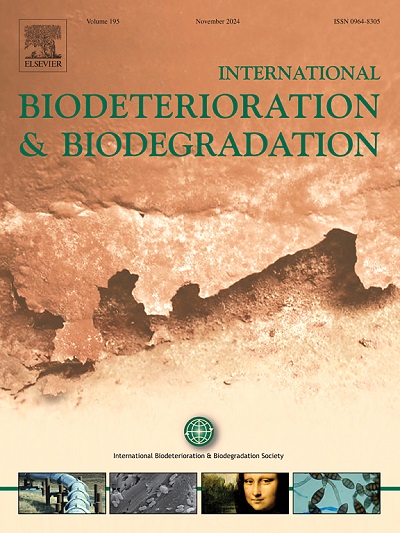Genomic and transcriptomic insights into benzoate and 4-hydroxybenzoate degradation in Arthrobacter sp. PAMC25564 isolated from cryoconite
IF 4.1
2区 环境科学与生态学
Q2 BIOTECHNOLOGY & APPLIED MICROBIOLOGY
International Biodeterioration & Biodegradation
Pub Date : 2025-05-19
DOI:10.1016/j.ibiod.2025.106125
引用次数: 0
Abstract
Arthrobacter sp. has long been recognized for its metabolic versatility, particularly in the degradation of xenobiotic compounds. They have been isolated from diverse environments, including extreme environments. In this study, we conducted biotransformation, genomics and transcriptomics of Arthrobacter sp. PAMC25564 isolated from the cryoconite of Wurmkogel, Ötztaler Alps, Austria, one of the extreme environments to unveil its aromatic compound-degrading potential. The strain possesses several genes associated with aromatic compound catabolism including at least one complete pathway to utilize two peripheral intermediates, 4-hydroxybenzoate (4-HB) and benzoate, which are mostly determined as wastewater contaminants. Arthrobacter sp. PAMC25564 tolerated and degraded benzoate and 4-HB up to 25 mM. Further, RNA-seq transcriptomics was done to investigate the benzoate and 4-HB degradation pathway in PAMC25564. The results indicate global gene regulation and pathway redundancy. Furthermore, growth of the strain in these aromatic compounds upregulates multiple genes associated with amino acid metabolism and phenylacetate degradation, which are associated with stress response. These findings contribute to a better understanding of aromatic compound degradation with a special focus on wastewater contaminants, benzoate and 4-HB degradation in Arthrobacter sp. PAMC25564.

从低温孢子中分离出来的PAMC25564节杆菌对苯甲酸盐和4-羟基苯甲酸盐降解的基因组学和转录组学研究
长期以来,节肢杆菌因其代谢的多样性而被人们所认识,特别是在降解外源性化合物方面。他们已经从不同的环境中分离出来,包括极端环境。在这项研究中,我们对从奥地利阿尔卑斯Ötztaler Wurmkogel的低温孢子中分离出来的节肢杆菌sp. PAMC25564进行了生物转化、基因组学和转录组学研究,以揭示其降解芳香族化合物的潜力。该菌株具有多个与芳香族化合物分解代谢相关的基因,包括至少一个完整的途径来利用两种外周中间体,4-羟基苯甲酸酯(4-HB)和苯甲酸酯,这两种物质主要被确定为废水污染物。PAMC25564耐受并降解苯甲酸盐和4-HB达25 mM。此外,通过RNA-seq转录组学研究PAMC25564中苯甲酸盐和4-HB的降解途径。结果表明存在全局基因调控和路径冗余。此外,在这些芳香族化合物中,菌株的生长上调了与氨基酸代谢和苯乙酸降解相关的多个基因,这些基因与胁迫反应有关。这些发现有助于更好地理解芳香族化合物的降解,特别关注废水污染物,苯甲酸盐和4-HB降解在节杆菌sp. PAMC25564。
本文章由计算机程序翻译,如有差异,请以英文原文为准。
求助全文
约1分钟内获得全文
求助全文
来源期刊
CiteScore
9.60
自引率
10.40%
发文量
107
审稿时长
21 days
期刊介绍:
International Biodeterioration and Biodegradation publishes original research papers and reviews on the biological causes of deterioration or degradation.

 求助内容:
求助内容: 应助结果提醒方式:
应助结果提醒方式:


